The Great Depression was an extremely difficult period around the world as a result of the depression that began in America. Unemployment reached to 25 percent in the United States, and most people’s bank savings were wiped out. People started migrating to other areas in search of jobs, and farmers began migrating in the false hope that the situation in neighboring areas would be better.
People who survived the Great Depression embedded habits into their lives that they found hard to change, such as refusing to part with anything that might come in handy at any future point in their life. To them, cutting off and discarding the ends of a loaf of bread is not a good idea and scraping the wrapper of a block of cheese certainly is. During this difficult time, people also learned smart budgeting by doing more with less.
Related: 50 Tips From the Great Depression
The Great Depression lasted for more than a decade, and people of that generation developed budgeting strategies that are effective even today. From a financial viewpoint, there’s definitely a lot we can learn from our elders, who survived a difficult past. Here are a few tips that our grandparents and great-grandparents used to survive the Great Depression.
#1. Reuse, Reduce, Recycle and Repair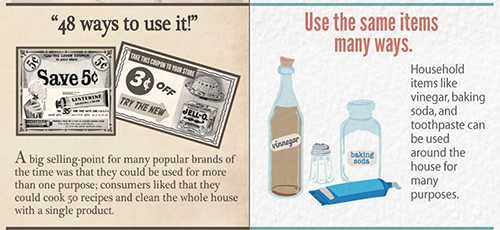
Our grandparents were experts in re-purposing things that had already been used. Recycling plastic bags by using them as trash bags and making use of old t-shirts and socks as rags are some amazing hacks we can learn from our elders. This is an excellent strategy for saving money. Instead of spending money buying new things, recycle and reuse is a technique that proves to be very beneficial for saving money.
#2. Pay With Cash More Often
During the Great Depression, people didn’t have enough savings in their bank accounts, and hence they used cash for any transactions. This strategy can save us from unwanted debts. Here’s why you absolutely must have food supplies, hard assets and reserve cash.
#3. Try to Be Self-Sufficient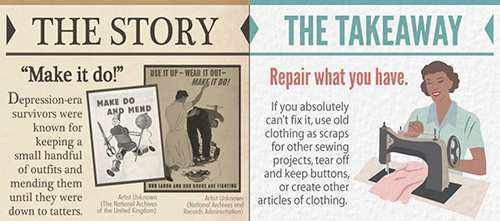
Americans adopted this strategy during the Great Depression by doing all their tasks for themselves. Sewing their own clothes, growing food on their own farms, and cooking from scratch are some strategies they adopted to save money. They mastered these skills to save money. We have to learn these skills from them.
#4. Budgeting Using a Diary or Envelopes
Our grandparents and great-grandparents did not have electronic gadgets to keep track of their budgets, so they used diaries and envelopes for budgeting their expenses. You can still use the traditional method of maintaining a diary by starting by planning how much you want to spend each month for each category, namely, housing, transportation, food, etc. You can keep several envelopes, each dedicated to a different category, and start by putting in the amount you allocate for each category. Use the money from each envelope for that purpose only. Here are 21 lost tips from 100 years ago – with illustrations.
#5. Buy Used Instead of New
If you are really serious about saving money, you will have to do so in every area. You can save a lot of money by buying used instead of new, including automobiles, toys, clothing, and so on. The barter system, which was a common practice during the Depression Era, is an excellent way to save money. You could even trade some of your skills in exchange for some fresh produce from a neighbor’s garden.
#6. Weigh Your Wants and Needs
It is essential to get meet your needs, but it is not necessary to satisfy all your wants. Americans learned to differentiate between their wants and needs during the Great Depression. If they did not have something they wanted, they learned to live without it. Similarly, you can follow suit here. If you already have something that meets your basic needs but you are looking to buy something better or a newer version, continue to use what you have instead of buying something new. For instance, wear clothes you already have instead of buying new ones, and use that two-year-old cell phone if it works well instead of getting yourself the latest model. This strategy is one of the most effective strategies that is also shared by many financial and budgeting experts. As Warren Buffet says, “If you buy things you don’t need, you will soon sell things you need.” This strategy holds true in the case of saving as well. Additionally, check these 11 survival tricks learned from homeless people.
#7. Try Your Hand at Freelancing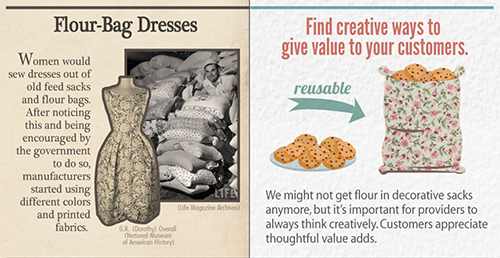
Even if you have a full-time job, earning some extra bucks is always a great idea. Many people back in the 1920s and 1930s did freelance work, such as selling photographs and home-cooked food. If you have a special skill or hobby, showcase that and earn some money as a passive income to keep the flow going. Today, there are many websites catering exclusively to freelancers, giving them the opportunity to sell their work online.
#8. Plant Those Seeds for a Lush Garden
Every time you bring vegetables or fruits home, do not forget to remove the seeds from some of them, dry them out, and then replant them in your own garden. This helps to keep your garden going all through the summer, and you won’t have to spend money buying veggies or fruits elsewhere. Americans used this method of growing seeds in their own farms back in the Depression Era.
#9. Let All the Members of Your Family Contribute
That’s exactly what Americans during the Great Depression Era did. Of course, if you have small children, they won’t be able to contribute financially, but they can help out in other ways. You and your spouse should both do your bit when it comes to taking up the financial burden of the whole family. Additionally, here’s how to get your wife and kids involved in prepping.
#10. Scrape to the Last Drop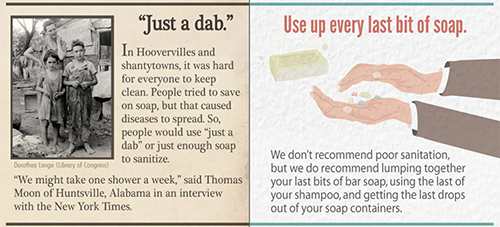
Yes, you read that right. Back in the 1930s, people never let go of even a single drop of their ketchup, toothpaste, shampoo, etc. They made sure that they scraped the bottles to the last bit. You definitely can save a lot by using everyday items to the last drop. As the saying goes, “Drop by drop forms a river.”
Surviving the Great Depression was a struggle, in fact, a nightmare for millions of people. But the tips and strategies people of that generation have left behind are invaluable. They lived their lives using whatever means of survival they had, and their strategies for saving money are applicable even today. Today’s economic policies are based on the wisdom gained during the Great Depression. Will another Great Depression occur today? Probably not. But we can still follow our grandparents’ lead when it comes to saving money.
You may also like:
Pioneer Recipes That Survived The California Trail
If You Are to Weak to Prep then You Need to Watch This (watch video)
10 Long Shelf-Life Canned Foods Every Prepper Should Consider Stockpiling
How to Make Your Own Semi-Automatic Off the Grid Washing Machine (No Electricity)

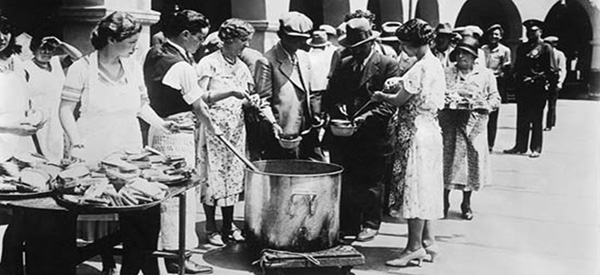













We could all stand to be more frugal and less wasteful. We are now raised in a “disposable society”. If it doesn’t work, or it’s broken, go get a new one. That won’t work with every device, or product, but many can be repaired and reused.
This is so so true. We Americans are sooooo spoiled. I don’t think we can survive another depression because we are so spoiled. But by using these techniques (learned from my grandparents who were parents during the Great Depression) we are debt free, have ample savings, and have put three kids through college with no debt. It works!
Cowboy
I am old enough to remember the 2 HUGE advertising campaigns of the late 1950s…and the 1960s
The first one taught Americans to stop recycling (& dispose of many things paper & plastic…after one use). Corporations successfully drummed up massive sales in that manner!
The other campaign taught Americans to live with credit cards!
Free Credit cards from MANY banks hit families, (and college students at their “dorm” addresses), like a tsunami!!!
I personally weathered a bankruptcy before I realized:
IF I CANNOT AFFORD TO SPEND MY OWN MONEY,
I SURE CANNOT AFFORD TO BUY MONEY – (AND @ a COMPOUND INTEREST RATE!)
Bad habits are hard to break.
And living with good habits is still not promoted culturally, as in a prior, saner, era+
My parents were young adults during the ’30s & ’40s. Many of above mentioned things like re-using shopping bags as trash bags & using bars of soap till there was nothing left, among many others were thankfully instilled in me as a child. The main thing I noticed about many people from that era is that once poverty comes to your doorstep and you taste it’s bitterness you never ever forget. Even though she lived comfortably later in life and had means, my mother never stopped living frugally and being thrifty. She passed away recently at the age of 87.
Only thing about planting seeds from veggies you buy most of them are high bred and don’t produce anything but a bush. Even when I buy plants I don’t buy the high bred.
I agree although there is a great book, Breed Your Own Vegetable Varieties by Carol Deppe, which devotes a whole chapter to back breeding hybrids to get an open pollinator similar to the original parent plants, but with the added benefits bestowed by the original cross (disease resistance, tall, short, colour etc.). Well worth the read if you have an interest in plants and their breeding possibilities.
Thanks for the lead on a book about back breeding hybrids, Ginny in West Australia! I had always read that seeds from hybrids were either sterile, or bore nothing edible. Having had the compost heap present me with some tasty, yet unidentifiable squash, and tiny, tasty tomatoes that were apparently throwbacks to some ancient wild ancestor, I look forward to doing some plant breeding of my own!
Those throw-back tiny tomatoes have yielded the most exquisite tomato flavor I’ve ever experienced! The seeds I saved from hybrid corn and squash, on the other hand, tend to produce flavorless tough offspring that were decorative at best. You cannot count on what you will get from 2nd – generation hybrids!! Experiment away–you may get lucky–but bet your belly on non-hybrids.
The problem with those high bred plants and seeds is that they are snooty, self-entitled and spoiled. They’re always putting on airs and can’t be bothered with producing anything more than showy foliage.
Hybrids on the other hand, bred from two distinct breeds, varieties, species, or genera, present combinations of traits that we as humans can selectively favor or eliminate. As the dominant species on the planet we have been doing it for many thousands of years.
Some “agribusinesses” produce hybrids which favor the company’s control of the product or may introduce processes and outcomes that are not generally favorable. Others have produced results which are generally favorable, such as disease resistance, broader range of tolerated growing conditions, wider variety of favored traits like taste, color or fertility, and increased yield.
When my grandfather had raised a particularly tasty tomato, he would always save a couple of slices to harvest the seeds from. I harvest my own seeds. If it tastes good, it gets saved.
When my grandfather had raised a particularly tasty tomato, he would always save a couple of slices to harvest the seeds from. I harvest my own seeds. If it tastes good, it gets saved.
Nothing new here. My parents lived through the great depression. I was born at the height of it. We lived the lessons all through my childhood. My wife lived through WWII in Japan. We both knew “mottainai”. That’s the Japanese expression for “Don’t waste anything.” Not only do we know it, we still practice it today. Remember, following the depression was WWII. During the War there were lots of things that were scarce. You couldn’t get butter. You bought oleomargarine which was white and had a little button of yellow food coloring so that you could knead the coloring through the block of margarine and make believe you were eating butter. You still didn’t believe it because margarine in those days tasted nothing like margarine these days. Did you ever put cardboard in your shoes because the shoemaker couldn’t get soles to repair your shoes? I did on several occasions during the War. I wore my older cousin’s clothes and my brothers wore them after they were too small for me. I never had to wear overalls though. That was a sign that things had really gotten bad for that family. We only had a couple of boys in grade school that had to wear overalls. Throw away the ends of a loaf of bread? Are you insane? That makes bread pudding. It makes french toast. It is only recently I found out that a tomato sandwich is “poor people food.” I read a list of poor people’s food on the internet. I was surprised at how many food items I enjoyed from my childhood were on the “poor people’s” food list. I guess I am just a poor boy at heart because I think sliced tomatoes with Hellmann’s mayonnaise is a good eating sandwich. Throw away an old T shirt? Why? Do you pay money for rags? I don’t. Besides, now I save the seams to use as wicks in emergency oil lamps. We never throw away a scrap of hand soap. It gets welded to the new bar and gets used up completely. After campaigning to get rid of paper bags, then the tree huggers campaigned to get rid of the plastic bags that replaced them to “save the tree.” I never threw away a plastic bag. By the time I finished with it, there was nothing useable left to do with it. Besides, this is an occasion where I think the “environmentalists” fell into a scheme by the grocery industry to save big bucks. How much money do you think Safeway is saving by selling bags rather than providing them to the customers with their purchase? Did your grocery bill go down due to that savings? If it did, I certainly didn’t notice it. I still have lots of plastic bags squirreled away but the day will come when I will be all out and then will probably have to buy plastic bags or find some substitute. There is nothing quite as handy as a plastic grocery bag for picking up and disposing of nasty stuff, animal scat, dead animals, that tiny remnant of lettuce way in the back of the ‘fridge that has reached final decomposition stage —
Thanks for the tip on T-shirt seams! Never thought of that one although not all are cotton these days. My parent were Depression teenagers so I learnt most of this also. I still add the sauce bottle leftovers to soup and stick the scrap of bar soap to the new bar. Waste not, want not.
True, which is why I make sure when I buy T shirts I only buy 100% cotton. Besides, they are cooler in the summer. Not so much in the winter, but I use other means to stay warm than a T shirt. I just added a quarter cup of water to the detergent jug which was “empty”. Vigorous shaking and there is enough detergent for two more loads of wash. The recycler wants us to rinse out the jug before putting it in the recycle bin. Well, I do, but the rinse water goes in the washer, not the drain.
I practice this with all containers..shampoo comes to mind.
We use body wash…for shampoo, bath, and shaving–why buy 3 products???
We really are a product of our upbringing. I do that also. I try to buy the soft pack refills and reuse the bottles but sometimes the shops trick you into paying more per unit for the refill, especially when the large bottle in on sale. Gotta watch those prices.
That’s why I only buy 100% cotton T shirts. Besides, they are cooler in the summer. Today I added 1/2 cup of water to the detergent jug. It was empty. Shave it vigorously and I have enough detergent for two more loads of wash.
Right on;very similar to my experiences;; I actually wore knickers until the first grade; what a relief to get trousers and;or shorts.
Aha! A use for T-shirt seams! Great! All things come to him who waits!
As for the plastic bag issue, the precipitating problem as I recall was the slobs who were just throwing them around outside, ending up choking and strangling the birds and clogging drains and swirling around with our other plastic debris in the Great Pacific Garbage Patch (that’s its real name!) that is somewhere between the size of Texas and twice the size of the continental US. NOT those of us who are using our practical ingenuity to reuse, reduce, and recycle them! For most of my shopping (and general hauling of small items from one place to another) I prefer canvas bags. They carry more, don’t easily get holes poked in them, are impervious to weather, and last forever. I do use the plastic bags for garbage, and sometimes that means patching the holes with a piece of tape from the dollar store so nothing leaks.
Does that make me a tree hugger? I’ve hugged worse!
My grandmother use to save the inner wax paper bags from inside boxes of cereal, cookie and cracker packages. Once you have finished with the contents, you remove the liner, carefully open it up along the seams, flatten it out and wipe it off good. She would fold it back up and use it in place of a roll of waxed paper. Thanks to Grandma, i never buy much waxed paper.
These are all sound and true methods that still stand the test of time. We live in such a “throw it away” and “got to have the latest and greatest now” society. Way too many people live on other peoples/company’s money because of this.
The others folks are the entitlement society, expecting the government to provide for all their needs, while they sit by and do nothing for themselves. Why? Because of pure LAZINESS! Shameful at the least and a fraud in reality!
I grew up in a family of twelve during the 50s and 60s. Equal to or near a great depression scenario. The norm was hand me downs, constant meals of Malto-o-Meal and the list could go on for days. Everyone worked –
Dad & Mom outside the home, Brothers & Sisters on the farm, garden and house and many days were very long. But we lived it, survived it and most importantly – Learned from it. It was often time very hard and almost cruel, but the character it instilled was and is priceless! Those lessons were and are ingrained into who I became then and also who I am today.
Our government has now engaged into the business of making the population dependent upon them. They started with small stuff (free milk at school lunch), then bigger (Free lunches) onto largest (Free breakfast, lunch and snacks at school). And that’s only one example! This my readers is the beginnings of Socialism in its purest form. You’d better look at Brazil right now if you want our country to go there – NOT GOOD!
I’ve prided myself in not accepting a single dollar from government entities in this fashion. I have earned, paid and made my own way for the past 50+ years. This pride is not gloating or beating my chest. Instead, it is the realization that this is how FREE and LIBERTY loving people live!
I fear my generation is a dying breed. I now watch and observe how my children, grandchildren and now great-grandchildren wait for and expect the hand-outs. Even though I taught them differently, they all are eating and accepting free stuff from the government and other sources. Thus they are not truly free, but instead indebted to and owing to those entities, which will be expecting them to act and behave in a certain way and/or face the consequences. In essence – owned by the government!
So the next time the government shows up at your door and asks what they can do to help you, tell them “absolutely nothing except get out of here now, stay out of my life and leave me alone!”. Then slam the door in their face and use the ten things above and the multitude of other ideas to make it for yourself and family. The difference you’ll feel looking at yourself in the mirror is huge!
This is preparing/prepping at its finest! Your character is your purpose and motivation that provide for obtaining and living the skills. The mirror never lies!
All you have to do is look at England to see how socialism has affected the people’s will to get off their duffs and off the dole. We see it in this country where generations exist on welfare. Households where the grandparents, parents and grandchildren are all on welfare and have never held a job in their lives. Yet they have tattoos, manicured nails with artwork and fancy hairstyling but terrible teeth. Money for tats but no money for dental work. Cable television with a big screen TV but are unable to afford food for their kids.
All the fruits and vegetables that spoil in fridge, don’t throw in the trash compost it. Even meats that might get freezer burn or forgotten in the back of the fridge. Boil it and if you have chickens then cut into small pieces and feed them. Or feed to your cats and dogs they will love you for it. Everything that passes through our hands can be reused. I too save plastic bags. Have several bundles stashed in end of world supplies. Great comments my friends. Keep them coming
I compost the greens and browns….etc. I feed the meats to my dogs….I can’t stand to throw food in the trashcan.
My grandmother grew up before Social Security or welfare. When her father died she was young so her mother, her two sisters and she went to live on a farm with her grandmother. All they had was what they could raise and sell from their farm. My grandmother was very thrifty. Bottles and cans always got rinsed so she could get the last drop. She even took her finger and cleaned out the last drop from an egg. She had chickens so any eatable scraps went to them. She had a garden and canned much that it produced. She wore heavy cotton stockings and, when they couldn’t be darned any more, she made rugs out of them. She patched bed sheets. Leftovers were made into a new meal-roadt chicken leftovers were made into a chicken pot pie, leftover ham was made into scalloped ham and potatoes and the bone was made into soup. She had a gadget called a soap saver which she used to put tiny pieces of soap into. Then you could swish it around in warm water to make a suds to wash your stockings. Vinegar and baking soda were her cleaning products.
Want to really save on that laundry detergent? Make your own. 1/2 bar of Fels Naptha soap, grated, 1/2 cup borax, 1/2 cup washing soda, mixed in and melted in 1 gallon of water on the stove. Then dilute it with 9 gallons of water. you now have 10 gallons of laundry soap for CHEAP! And you can still add water to your empty bottle to get the last of it. I save juice bottles that are easy to handle for storage and use.,
I know people who scoff at my cheapness and roll their eyes when I pick up a penny. But, my house was paid off five years earlier than scheduled. I once paid for a vacation with the change I picked up. Yeah. I’m cheap
If you wish for to increase your familiarity just keep
visiting this web page and be updated with the hottest news update posted here.
My mother worked mostly as a clerk and bookkeeper for a family owned grocery store during the deperssion. She supported her mother and nephew. They had a garden and dried and canned all excess for later. Soap scraps were put in a,tiny bag made from a well worn, doubled washcloth and hung in yhe bathtub or shower. Some soap scraps were also put in a small glass jar with some water to make soft soap for pretreating stains and hand washing. Nothing was wasted.
Quilts, patches, childrens clothing from wornout adult clothing, rag rugs of several sorts, stuffed toys, padding and covers on tin can footstools, cleaning rags, et. All just from old clothing. I wore floursack clothing into the mid 1950s when Mom couldn’t get them any longer. I still remake clothing from lovely fabrics to fit me. I make throw pillows from colorful clothing or tee shirts. I learned to sew at age 5, knit at 7, crochet at 9.
We sun dried fruits and some vegetables and always canned fruits and vegetables. Mom crocheted a whole livingroom rug while I made one to put by my bed. When we started getting plastic bags I crocheted some into a thick cushiony rug to put at the kitchen sink. Plastic grocery bags fit the little trash containers in almost every room.
Food cans get colorful tape, paint, permenant marker designs then they become pencil holders, craft and sewing irem holders. They can be used singly or grouped together and glued or tied. Juice cans or oatmeal containers were grouped together in a flower shape. Then cut out two shaped to match pieces with 1/4″ seams added. Then cut a long strip the height of the containers plus 1/4″ on both edges. Sew the flower shapes and straight piece together leaving enough opening to put in the containers. Put old rags or new filler under the top flower shape to pad your footstool. Close up the side with hand stitches. We embroiderd the seam around the flower shapes. Oriental poufs are popular decorator itens today. They were made of 8 pieces with trianged ends to make a round stool filled with rags. The cover was pretty and embroidered to disquise the humble insides.
Bit of food and leftovers become casseroles and soups. Herbs down to the last pinch are seasonings, teas, and added to herb blends.
I’ve stuffed throw pillows with plastic bags covered with rags then a layer of fluffy stuffy material. Pillow forms are lovely but not cheap.
plastic bags can also be used as overshoes in an emergency. in the 1950 s and before many people also wore rubbers [overshoes] to save and protect there shoes
I have used throwaway grocery bags to make sleeping mats for the homeless as well as the things mentioned here.
Old pie pans and can lids with pull tabs are great bird chasers in fruit trees, grapes or bushes. Also on posts,around a strawberry bed.
My daughter makes a refreshing summertime drink from honey, cider vinegar,and cold water.
Who hasn’t made Sun tea?
Soups for a crowd were made of all leftovers. Add more tomato, diced potatoes, et or pasta to make it stretch, add flavor. Add bullion to make a rich flavor.
I used to save all leftovers in a gallon glass jar. Add extras to it from whatever I could find. Then season with bullion. Beans, spaghetti, veggies, bits of meats, were all mixed and seasoned till they were tasty. I used this to supplement lunches for our tiny school and any Parents that happened to be nearby. A lot of the guys would come with their sandwiches and have a bowl of warm soup. It was the 1980s and mines in our area were closing and incomes drying up.
I had 4 kids, a mother and 4 more kids living with us and other students often stayed with us during the week. Not lots of leftovers but I always saved every bit and added enough corn, peas, mixed vegetables, diced tomatoes to quickly fill the jar. Then most of a jar of water, the broth from any canned vegetables and added butter that might have been in the serving bowl. Together it made 2-3 gallons of soup when seasoned and heated. Spaghetti was a weekly addition and sometimes boiled diced potatoes or cooked macaroni to make it more hearty. Surprising, many looked forward to the three days we had soup. It made for popular gatherings at lunchtime with lots of laughter and great memories. I still make “leftovers” soups or casseroles. It is good seasonings or crumb toppings that make the Dish good.
Thanks to everyone who contributes valuable information and experiences to this forum!!
being frugal and avoiding wasting is a good way to live